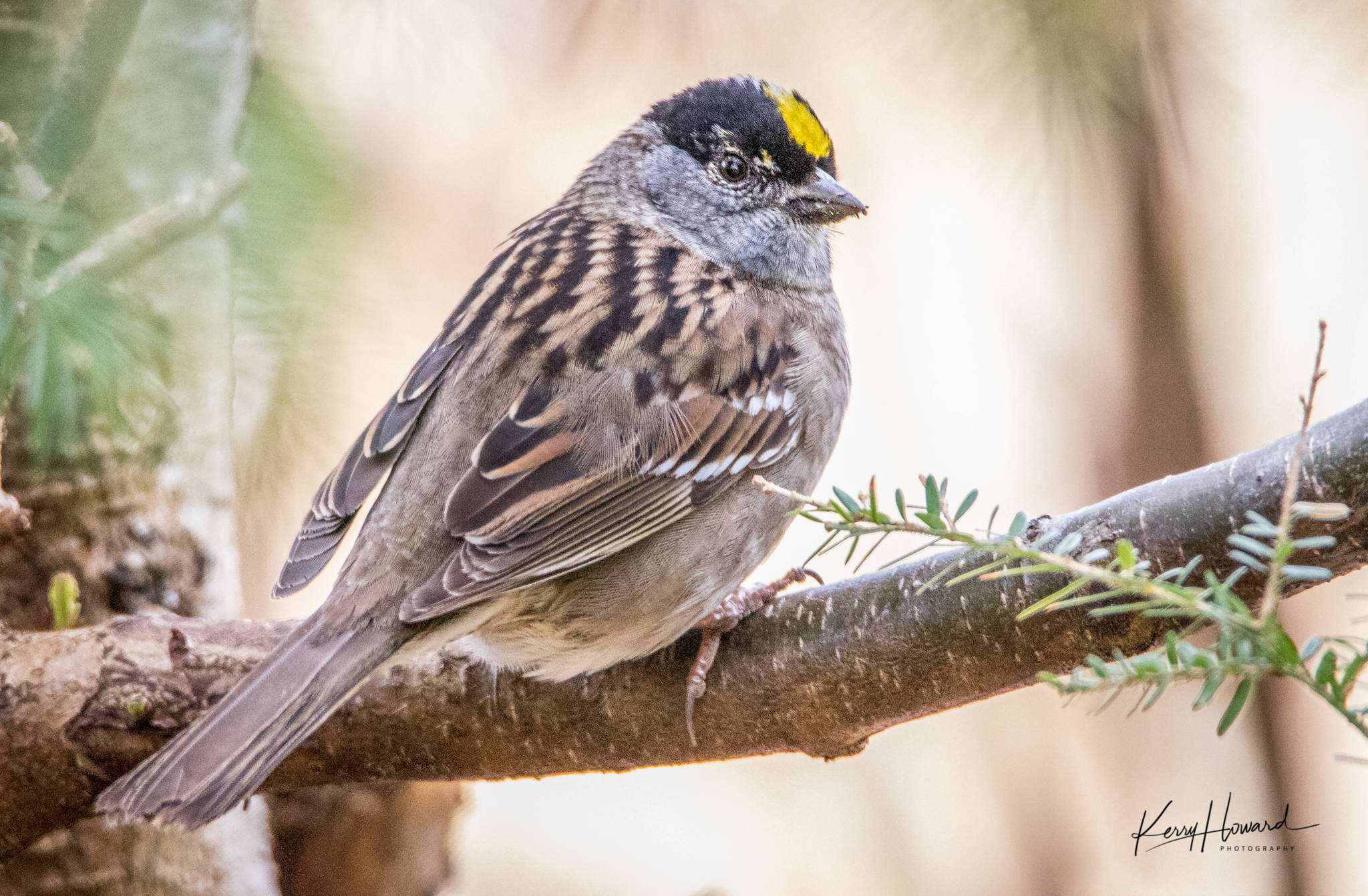The end of April and early May brought signs that our reluctant spring was finally happening, at least at low elevations. The bright yellow display of skunk cabbage made a welcome contrast with the somber greens of conifers and the still-leafless deciduous trees. A close look at the spike-like inflorescence showed that the numerous individual flowers were all still in their female phase, with no signs yet of the pollen that eventually appears around each pointed stigma. The small brown beetles that are the chief pollinators had yet to show up; they prefer inflorescences with pollen. Deer had munched off the tops of many inflorescences, leaving just a stub with a few flowers.
We found several fern-leaf goldthread plants with their wispy, narrow-petalled flowers, which are pollinated by small flies. The early blueberries were in bloom, their pinkish-white flowers waiting for bumblebees to visit. On sun-warmed cliffs along Perseverance Trail, the first purple mountain saxifrage plants made a splendid show; they are pollinated by bumblebees and probably some other insects. And there are reports of yellow violets along some trails.
We enjoy those floral offerings, but they are a dramatic contrast with what happens in early spring in the forests of the Midwest. There, the forest floor is liberally decorated by the early flowers of many species, including bloodroot, spring beauty, dutchman’s breeches, dogtooth “violet,” among others, many of which have showy white petals. Most of these species require an insect pollinator for seed production, and that job is often done by various species of native, non-social, solitary bees and by the non-native honeybee. Here in Southeast, I am told that such solitary bees occur, but almost nothing is known about their ecology.
The avian world was promising, too, with hooters on the hillsides and kinglets in full song, along with wrens, robins, varied thrushes, juncos and fox sparrows starting to tune up; other sparrows and early warblers arriving but were not yet very vocal; chickadees with nest material and — in some places — eggs in their nests; sapsuckers excavating nest cavities; the first hermit thrushes skulking in the understory; hummers zipping to and fro; flights of violet-green and tree swallows swooping after flying insects. It is always such fun to see and hear the forest awakening each spring.
A few weeks ago I wrote about our local moose population, noting that population growth might be slow, given that only a few moose were known to be in this area. Well, now there are fewer still. A bear reportedly killed one in Cowee Meadows, and I found the remains of one, killed by a human hunter, in another place.
A little walk on the beach along the Mendenhall Peninsula yielded lots of ducks: the usual mallards, plus widgeon, greenwing teal, and shovellers. I was surprised to see hundreds of scoters rafted up in the lower reaches of the river; they are usually out in the bay. Shorebirds were migrating through, with pipits foraging among them.
Ravens turned over a cluster of mussels and barnacles, exposing an enormous hairy hermit crab with its abdomen tucked (inadequately) into a moonsnail shell. They were actively foraging on barnacles, nipping and hacking at the shells. We also found several regurgitated deposits of broken barnacle shells, where the birds had jettisoned the undigestible bits. A couple of ravens near a torn-up patch of sand drew our attention. With their powerful bills, they had just excavated three holes, about 5 inches deep, and extracted the clams that had been buried there, cracking open the shells to extract the meaty morsels inside. As we stopped to watch, a raven was just finishing off the last clam.
On my home pond, a few pairs of mallards found peace and quiet, with lots of spilled bird seed on the fast-disappearing ice. But by early May, the ice was gone. The duck crowd had grown, sometimes to twelve or fifteen, now squabbling over the spilled seed. Most of the females probably had a clutch of eggs in progress, but males were largely still in prime breeding dress, no doubt in hopes of some delayed mating opportunities.
A leisurely stroll around the Crow Point/Boy Scout beach area found a flock of golden-crowned sparrows in the woods along the river and a couple of groups of savanna sparrows along the grassy upper edge of the beach. A flock of dunlin (I think) swirled over the sand flats. In the big, broad meadow I call the “goose-flats,” several white-fronted geese mingled with the usual gang of Canada geese, all grubbing for tasty greens and roots, while, off to one side and separate, a flock of snow geese also foraged intently. I circled around all of them at a distance, and so disturbed them not at all.
Elderberry and wild currant bushes leafed out ahead of most other deciduous woody plants, but by the end of the first week of May, bits of green were showing also on willows and alders. In the beach meadows, green shoots were popping up everywhere. It’s “green-up” time!
• Mary F. Willson is a retired professor of ecology. “On The Trails” appears every Friday. Her essays can be found online at onthetrailsjuneau.wordpress.com.

